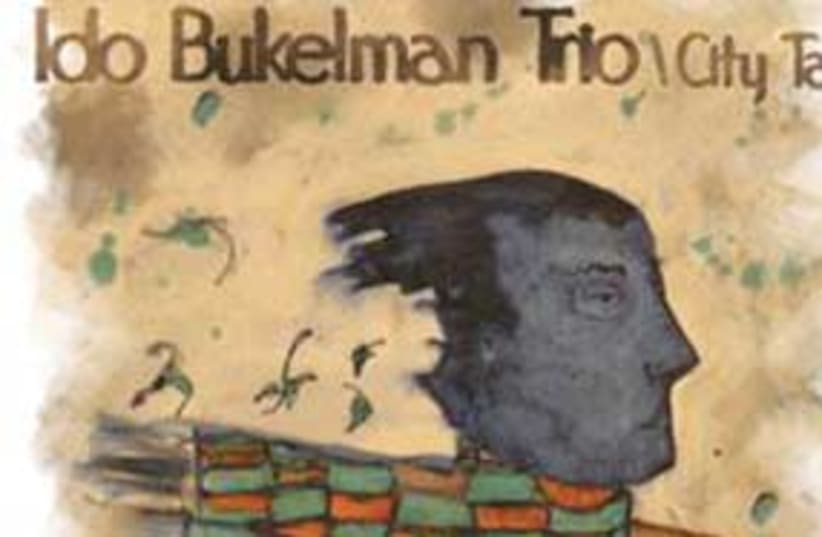City TailIdo Bukelman has a lot going for him and, evidently, plenty to offer. The twenty-something Jerusalemite jazz guitarist is one of a growing breed of young local artists who look for their musical muse on the less fettered side of the tracks.City Tail, Bukelman’s debut offering (release no. 2 is already in the works), wags along a meandering trail through lush pastureland, not a few prickly bushes and some dense undergrowth. The 8-track self-penned album feeds off a wide range of idioms and sources. The opener, “Seagull Shore,” for example, immediately draws the listener into a sonic vortex of glistening guitar textures couched in sumptuous bass colors – courtesy of Assaf Hakimi – while drummer Udi Shlomo sprinkles filigree cymbal seasoning over the increasingly bluesy, synthesizer-inflected, guitar lead.The mix becomes far more energized on “Ornette” as Bukelman throws in a generous dosage of distortion punctuated by some no-nonsense drum work. Hakimi, meanwhile, maintains a velvety undertow that consummates the textural picture. The album’s sonority peaks on “Half-time City” but there are plenty of budding gems to enjoy on City Tail.Listeners in need of reference points will, no doubt, discern influences from sixty-something guitarist John Abercrombie – not at all a bad source of inspirational nourishment.Paul Motian, Chris Potter, Jason Moran
Lost In A DreamIconic 79-year-old drummer Paul Motian has been mixing it with the jazz world’s greats for over half a century, including synergies with the likes of pianist Bill Evans, Thelonious Monk and Coleman Hawkins.For much of his career Motian has displayed a penchant for trio settings of various instrumental combinations. His current threesome features saxophonist Chris Potter, with whom Motian has worked on and off for over 15 years, while pianist Jason Moran is a new bandstand partner for the veteran drummer.On Lost In A Dream the three players dovetail, support and spark off each other as the mood and energy levels ebb and flow. Moran, who has served sideman slots with saxophone titan Charles Lloyd, provides consummate support throughout, as well as delivering mellifluously lyrical passages and rhythmically adventurous sorties.Potter, on the other hand, has been leading his own bands for some time now and has gained a reputation for his muscular delivery. Here, however, he largely reins in his power in order to complement Motian’s drum work, which ranges from filigree brushwork to powerhouse thudding. But a player of Potter’s undoubted caliber cannot be held in check for too long and there are some delightful saxophone riffs that imbue the whole album with a palette of colors that range from lush deep hues to gently inferred pastels, interspersed by a splattering of acerbic statements.All three players are clearly keenly aware of where the others are at any given moment. On “Birdsong”, for example, the piano and saxophone complement each other while also seamlessly fusing their sound into a multilayered stratum.“Drum Music,” aptly, opens with a drum solo that owes something to Art Blakey, but then the plot thickens and Moran comes tearing in with some robust staccato fingering that provides a powerful rhythmic substratum to his own melodic continuum. “Abacus” is possibly the most cohesive track on the album, with Potter setting out the melodic intent which is soon echoed and embellished by Moran while Motian seasons with delicate brushwork before producing a cavernous solo spot.New England Conservatory
Art-I-FactsArt-I-Facts is a evidently a treasure of great performances, featuring select jazz concerts performed at the venerable New England Conservatory (NEC) in Boston over the 40 years since the jazz department was established there. All the soloists are either teachers or alumni of the institute and they include such stellar figures as pianists Jaki Byard and Ran Blake, soprano saxophonist Steve Lacy and trombonist Bob Brookmeyer.This is a fingerlicking compilation which alludes to a plethora or recorded gems that must, surely, be stashed away somewhere in the NEC’s vaults. One can only hope that the jazz loving public gains access to more concerts recorded at the institute since 1969.All 14 numbers on the CD are of the highest quality, with NEC jazz department founder – now 85 years old – composer, conductor, author and historian Gunther Schuller among the conductors.Such is the quality of the material, that it is hard to pick out cutsthat stand out prominently from the others. However, if pressed, onecould point to Joe Maneri’s clarinet lead on a peerless rendition oftraditional Greek song “Zeibekiko” recorded in 1976, while Lacy’s solo“Thelonious” from 2002 is both melodically inviting and texturallybeguiling. Then there’s John Coltrane’s “India” which is given the fulltreatment by tenorist George Gazone, with bassist John Lockwood anddrummer Bob Moses keeping the ship on a rock solid keel from start tofinish.Among the many illustrious graduates from NEC are Israelicomposer-pianist Yitzhak Yedid and Israeli vocalist Ayelet RoseGottlieb, and, who knows, we might even be able to enjoy someNEC-recorded contributions from them on some future compilation fromthis hallowed Boston institution.
